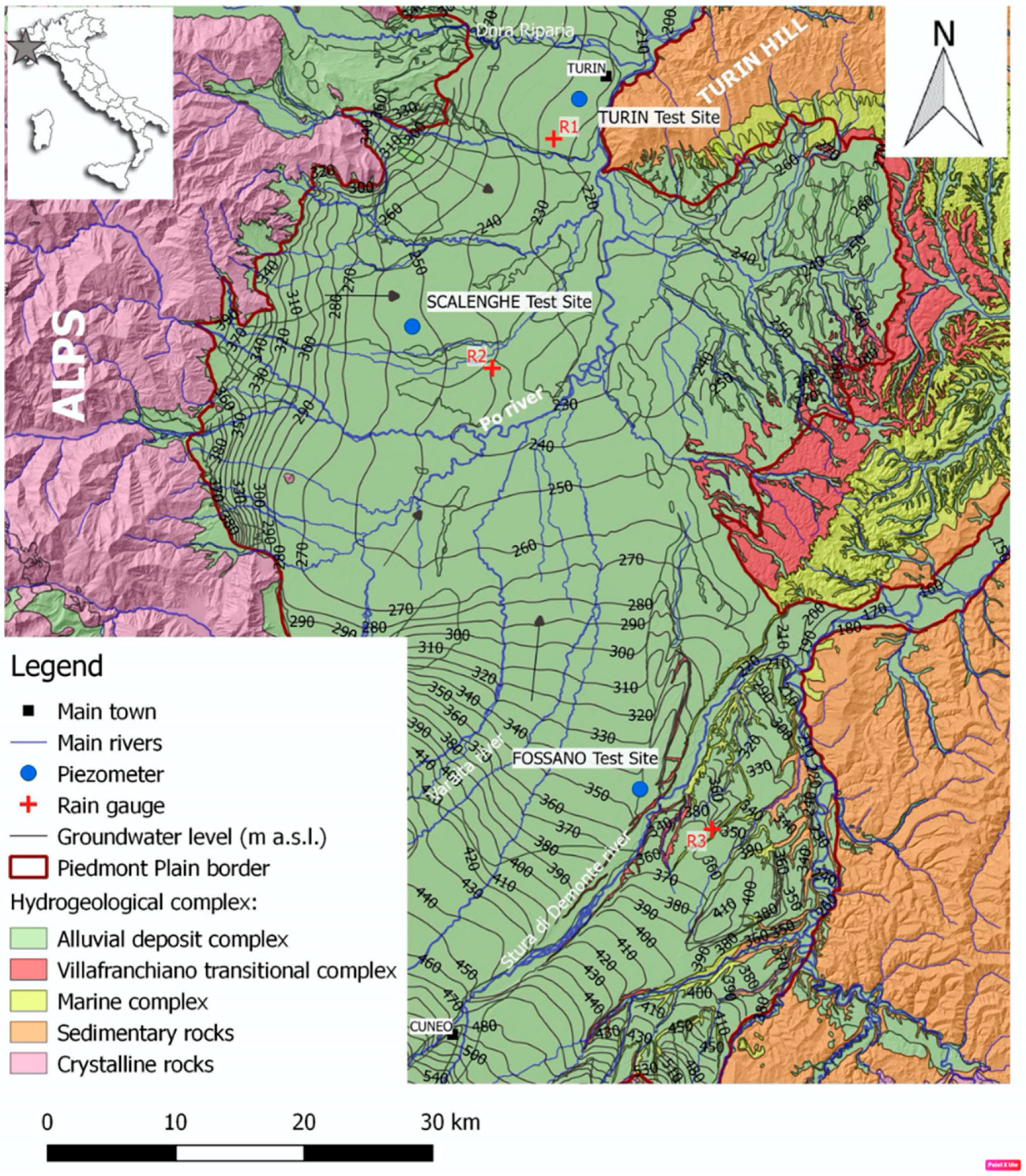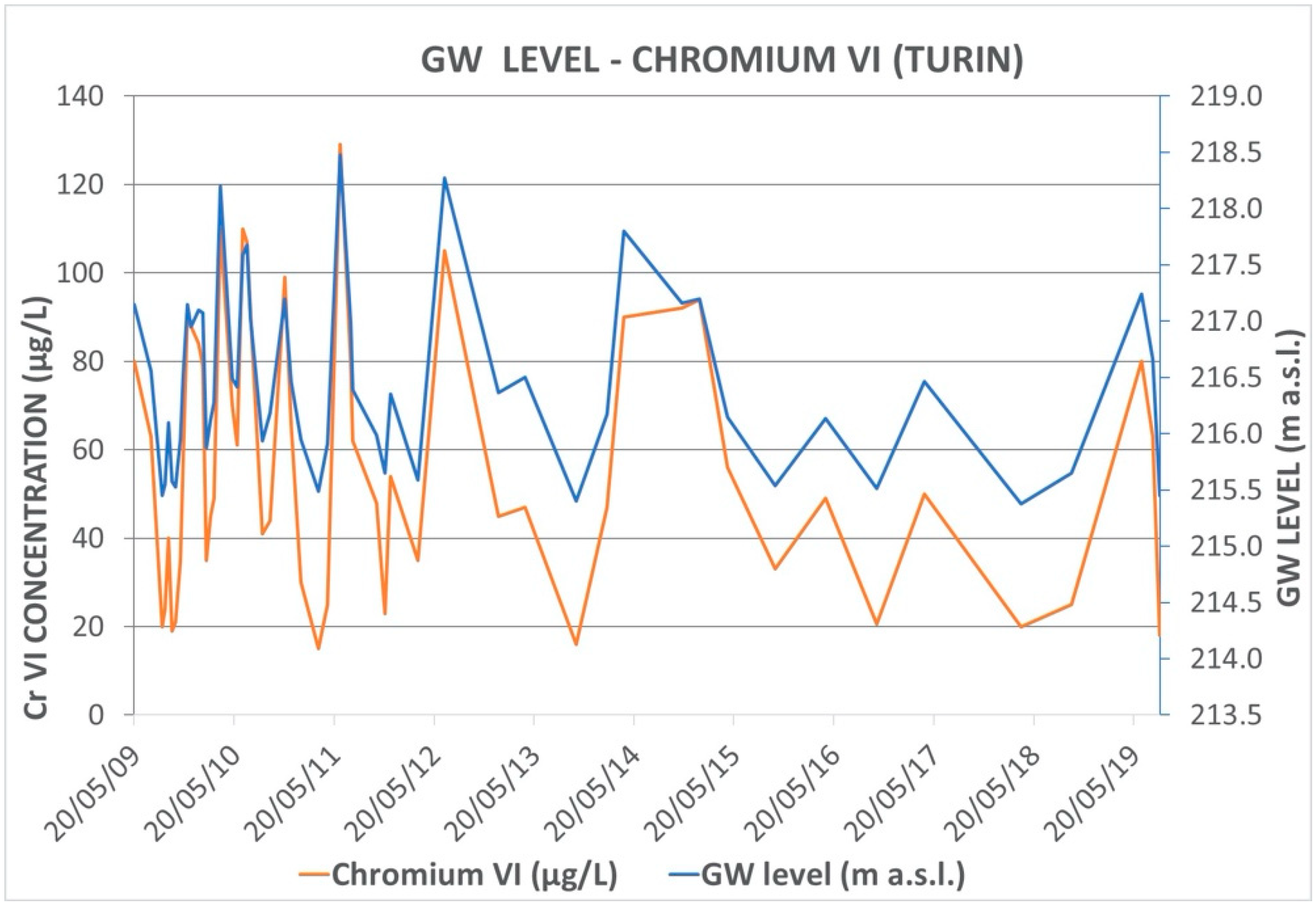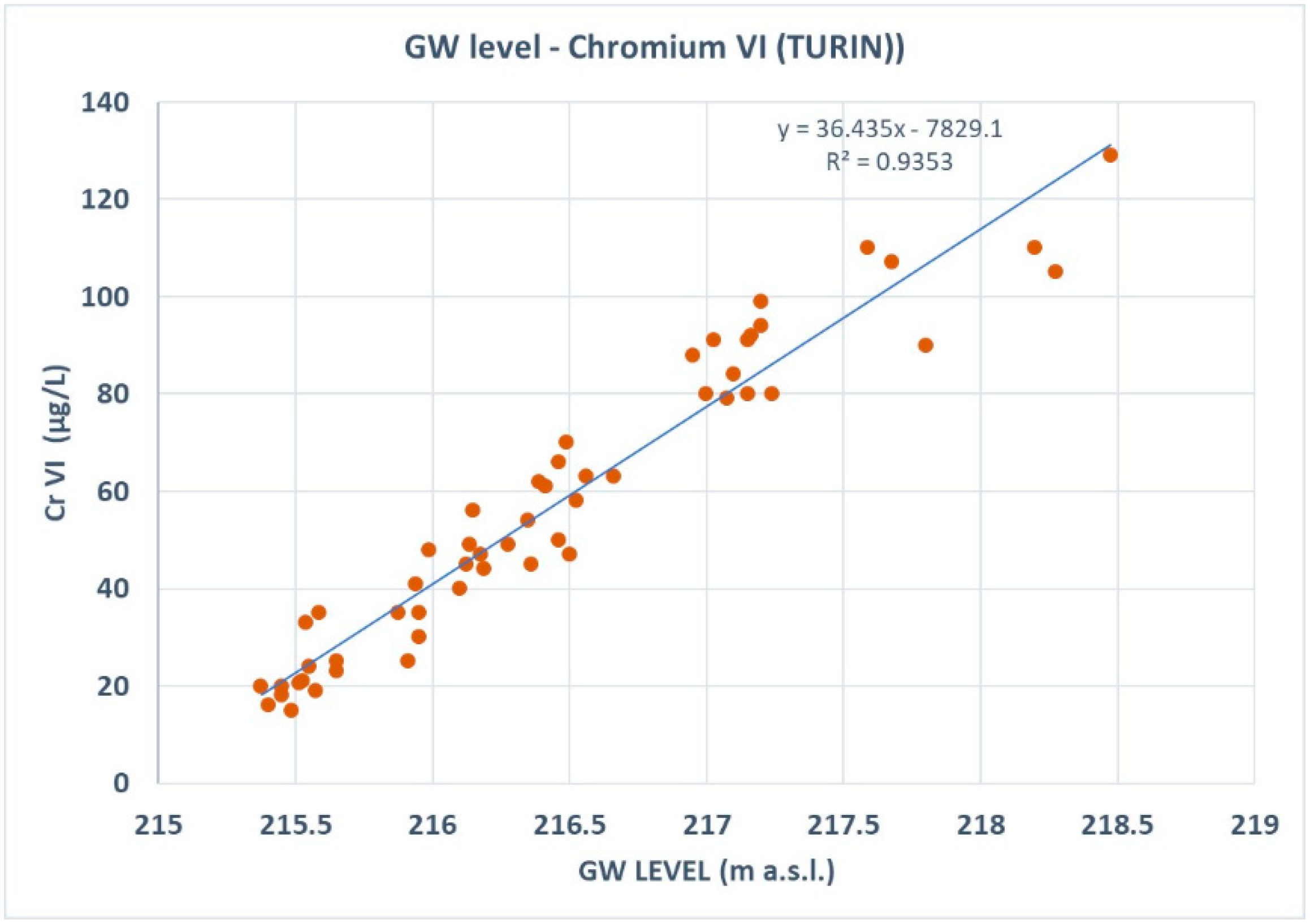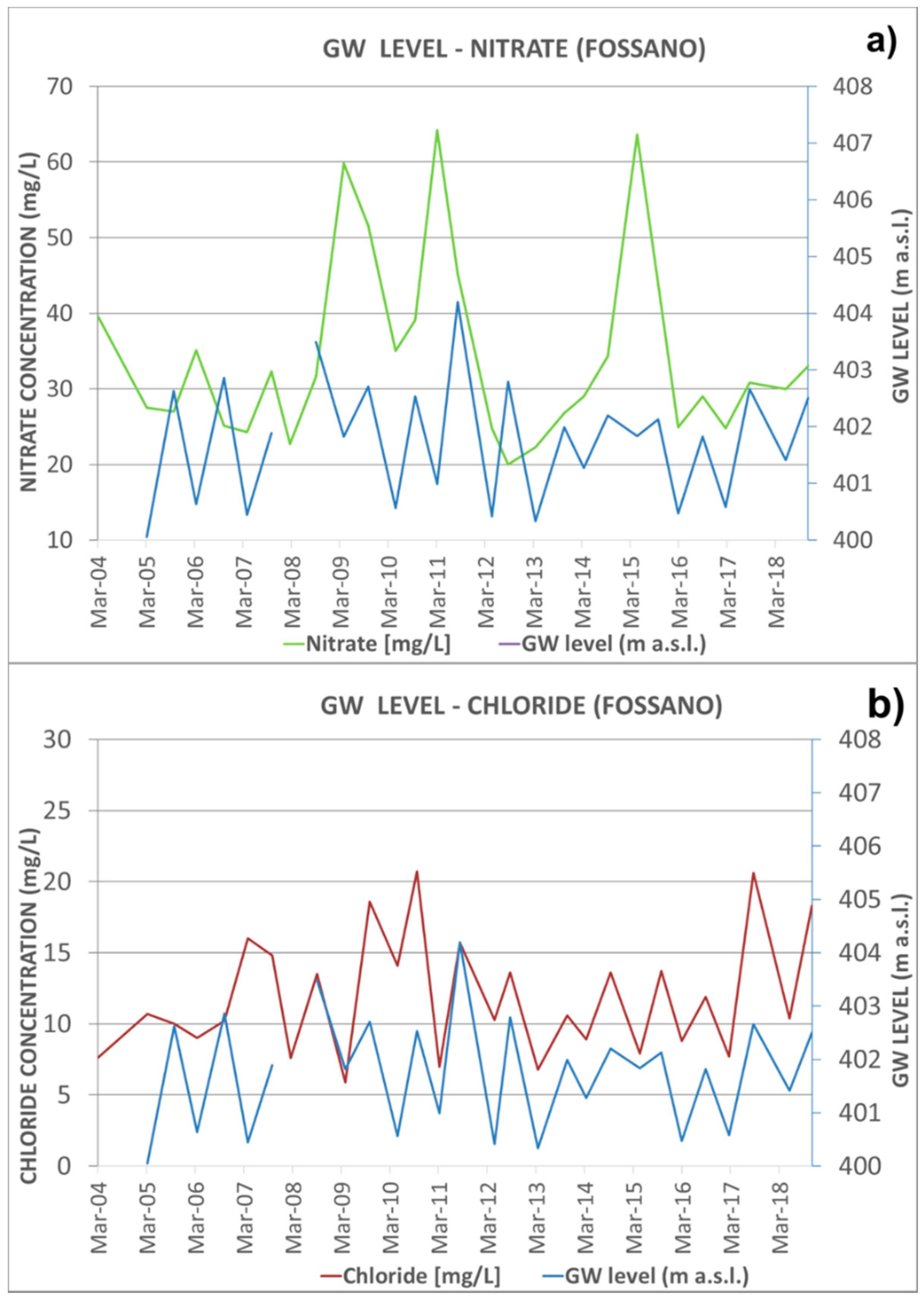Meteorological Variability and Groundwater Quality: Examples in Different Hydrogeological Settings
Abstract
1. Introduction
2. Materials and Methods
2.1. Study Areas
2.2. Meteorological and GW Level Data Sets
2.3. Chemical Analyses
2.4. Statistical Analysis
3. Results
4. Discussion and Conclusions
Author Contributions
Funding
Acknowledgments
Conflicts of Interest
References
- Parry, M.; Parry, M.L.; Canziani, O.; Palutikof, J.; Van der Linden, P.; Hanson, C. Climate Change 2007-Impacts, Adaptation and Vulnerability; Working Group II Contribution to the Fourth Assessment Report of the IPCC; Cambridge University Press: Cambridge, UK; New York, NY, USA, 2007; Volume 4. [Google Scholar]
- IPCC. Climate Change 2014: Impacts, Adaptation, and Vulnerability. Part A: Global and Sectoral Aspects; Field, C.B., Barros, V.R., Dokken, D.J., Mach, K.J., Mastrandrea, M.D., Bilir, T.E., Eds.; Contribution of Working Group II to the Fifth Assessment Report of the Intergovernmental Panel on Climate Change; Cambridge University Press: New York, NY, USA, 2014; p. 1132. [Google Scholar]
- Delpla, I.; Jung, A.V.; Baures, E.; Clement, M.; Thomas, O. Impacts of climate change on surface water quality in relation to drinking water production. Environ. Int. 2009, 351, 225–1233. [Google Scholar] [CrossRef] [PubMed]
- Taylor, R.G.; Scanlon, B.; Döll, P.; Rodell, M.; Van Beek, R.; Wada, Y.; Longuevergne, L.; Leblanc, M.; Famiglietti, J.S.; Edmunds, M.; et al. Ground water and climate change. Nat. Clim. Chang. 2013, 3, 322–329. [Google Scholar] [CrossRef]
- Green, T.R.; Taniguchi, M.; Kooi, H.; Gurdak, J.J.; Allen, D.M.; Hiscock, K.M.; Treidel, H.; Aureli, A. Beneath the surface of global change: Impacts of climate change on groundwater. J. Hydrol. 2011, 405, 532–560. [Google Scholar] [CrossRef]
- van der Gun, J. Groundwater and Global Change: Trends, Opportunities and Challenges; United Nations Educational: Paris, France, 2012; ISBN 978-92-3-001049-2. [Google Scholar]
- Döll, P.; Fiedler, K. Global-scale modelling of groundwater recharge. Hydrol. Earth Syst. Sci. 2008, 12, 863–885. [Google Scholar] [CrossRef]
- Döll, P. Vulnerability to the impact of climate change on renewable groundwater resources: A global scale assessment. Environ. Res. Lett. 2009, 4, 035006. [Google Scholar] [CrossRef]
- Braca, G.; Bussettini, M.; Ducci, D.; Lastoria, B.; Mariani, S. Evaluation of national and regional groundwater resources under climate change scenarios using a GIS-based water budget procedure. Rend. Lincei Sci. Fis. Nat. 2019, 30, 109–123. [Google Scholar] [CrossRef]
- Kløve, B.; Ala-Aho, P.; Bertrand, G.; Gurdak, J.J.; Kupfersberger, H.; Kværner, J.; Muotka, T.; Mykra, H.; Preda, E.; Rossi, P.; et al. Climate change impacts on groundwater and dependent ecosystems. J. Hydrol. 2014, 518, 250–266. [Google Scholar] [CrossRef]
- Aladejana, J.A.; Kalin, R.M.M.; Sentenac, P.; Hassan, I. Assessing the Impact of Climate Change on Groundwater Quality of the Shallow Coastal Aquifer of Eastern Dahomey Basin, Southwestern Nigeria. Water 2020, 12, 224. [Google Scholar] [CrossRef]
- Custodio, E. Trends in Groundwater Pollution: Loss of Groundwater Quality & Related Services. Groundwater Governance: A Global Framework for Action, GEF-World Bank-UNESCO. Available online: http://www.groundwatergovernance.Org/fileadmin/user_upload/groundwatergovernance/docs/Themat (accessed on 5 February 2020).
- van Vliet, M. Impact of Climate Change on Groundwater Review; IGRAC Report for TNO Bouw en Ondergrond: Delft, The Netherlands, 2007. [Google Scholar]
- Holman, I.P. Climate change impacts on groundwater recharge-uncertainty, shortcomings, and a way forward? Hydrogeol. J. 2006, 14, 637–647. [Google Scholar] [CrossRef]
- Green, T.R.; Taniguchi, M.; Kooi, H. Potential impacts of climate change and human activity on subsurface water resources. Vadose Zone J. 2007, 6, 531–532. [Google Scholar] [CrossRef]
- Bovolo, C.I.; Parkin, G.; Sophocleous, M. Groundwater resources, climate and vulnerability. Environ. Res. Lett. 2009, 4, 035001. [Google Scholar] [CrossRef]
- Fallahati, A.; Soleimani, H.; Alimohammadi, M.; Dehghanifard, E.; Askari, M.; Eslami, F.; Karami, L. Impacts of drought phenomenon on the chemical quality of groundwater resources in the central part of Iran—Application of GIS technique. Environ. Monit. Assess. 2020, 192, 64. [Google Scholar] [CrossRef] [PubMed]
- Lasagna, M.; Mancini, S.; De Luca, D.A. Groundwater hydrodynamic behaviours based on water table levels to identify natural and anthropic controlling factors in the Piedmont Plain (Italy). Sci. Total Environ. 2020, 716, 137051. [Google Scholar] [CrossRef] [PubMed]
- Bloomfield, J.P.; Jackson, C.R.; Stuart, M.E. Changes in Groundwater Levels, Temperature and Quality in the UK Over the 20th Century: An Assessment of Evidence of Impacts from Climate Change. LWEC, p. 14, (UNSPECIFIED). 2013; Available online: http://www.lwec.org.uk/publications/water-climate-change-impacts-report-card/1-groundwater-temperature-quality (accessed on 10 March 2020).
- Arnell, N.W. Climate change and water resources in Britain. Clim. Chang. 1998, 39, 83–110. [Google Scholar] [CrossRef]
- Alley, W.M. Ground water and climate. Ground Water 2001, 39, 161. [Google Scholar] [CrossRef]
- Lasagna, M.; Mancini, S.; De Luca, D.A.; Cravero, M. Piezometric levels in the Piedmont plain (NW Italy): Trend and hydrodynamic behaviour of the shallow aquifer. Rend. Online Soc. Geol. It. 2019, 48, 2–9. [Google Scholar] [CrossRef]
- Hanson, R.T.; Dettinger, M.D.; Newhouse, M.W. Relations between climatic variability and hydrologic time series from four alluvial basins across the southwestern United States. Hydrogeol. J. 2006, 14, 1122–1146. [Google Scholar] [CrossRef]
- Aribisala, J.O.; Awopetu, M.S.; Ademilua, O.I.; Okunadel, E.A.; Adebayo, W.O. Effect of climate change on groundwater resources in southwest Nigeria. J. Environ. Earth Sci. 2015, 5, 12. [Google Scholar]
- Dragoni, W.; Sukhija, B.S. Climate Change and Groundwater; Dragoni, W., Sikhija, B.S., Eds.; Geological Society, Special Publications: London, UK, 2008; Volume 288, pp. 1–12. [Google Scholar]
- Bloomfield, J.P.; Williams, R.J.; Gooddy, D.C.; Cape, J.N.; Guha, P.M. Impacts of climate change on the fate and behaviour of pesticides in surface and groundwater—A UK perspective. Sci. Total Environ. 2006, 369, 163–177. [Google Scholar] [CrossRef]
- Stuart, M.E.; Gooddy, D.C.; Bloomfield, J.P.; Williams, A.T. A review of the impact of climate change on future nitrate concentrations in groundwater of the UK. Sci. Total Environ. 2011, 409, 2859–2873. [Google Scholar] [CrossRef]
- Sugita, F.; Nakane, K. Combined effects of rainfall patterns and porous media properties on nitrate leaching. Vadose Zone J. 2007, 6, 548–553. [Google Scholar] [CrossRef]
- Gurdak, J.J.; Hanson, R.T.; McMahon, P.B.; Bruce, B.W.; McCray, J.E.; Thyne, G.D.; Reedy, R.C. Climate variability controls on unsaturated water and chemical movement, High Plains aquifer, USA. Vadose Zone J. 2007, 6, 533–547. [Google Scholar] [CrossRef]
- Taylor, C.A.; Stefan, H.G. Shallow groundwater temperature response to climate change and urbanization. J. Hydrol. 2009, 375, 601–612. [Google Scholar] [CrossRef]
- Bucci, A.; Barbero, D.; Lasagna, M.; Forno, M.G.; De Luca, D.A. Shallow groundwater temperature in the Turin area (NW Italy): Vertical distribution and anthropogenic effects. Environ. Earth Sci. 2017, 76, 221. [Google Scholar] [CrossRef]
- Bucci, A.; Barbero, D.; Forno, M.G.; Lasagna, M.; De Luca, D.A. Urban groundwater warming in Turin area (NW Italy). Rend. Online Soc. Geol. It. 2019, 47, 2–6. [Google Scholar] [CrossRef]
- Mastrocicco, M.; Busico, G.; Colombani, N. Deciphering Interannual Temperature Variations in Springs of the Campania Region (Italy). Water 2019, 11, 288. [Google Scholar] [CrossRef]
- Debernardi, L.; De Luca, D.A.; Lasagna, M. Correlation between nitrate concentration in groundwater and parameters affecting aquifer intrinsic vulnerability. Environ. Geol. 2008, 55, 539–558. [Google Scholar] [CrossRef]
- Lasagna, M.; Franchino, E.; De Luca, D.A. Areal and vertical distribution of nitrate concentration in Piedmont plain aquifers (North-western Italy). In Engineering Geology for Society and Territory-Volume 3; Springer: Berlin/Heidelberg, Germany, 2015; pp. 389–392. [Google Scholar] [CrossRef]
- Lasagna, M.; De Luca, D.A.; Franchino, E. Nitrate contamination of groundwater in the western Po Plain (Italy): The effects of groundwater and surface water interactions. Environ. Earth Sci. 2016, 75, 240. [Google Scholar] [CrossRef]
- Lasagna, M.; De Luca, D.A.; Franchino, E. The role of physical and biological processes in aquifers and their importance on groundwater vulnerability to nitrate pollution. Environ. Earth Sci. 2016, 75, 961. [Google Scholar] [CrossRef]
- Lasagna, M.; De Luca, D.A.; Franchino, E. Intrinsic groundwater vulnerability assessment: Issues, comparison of different methodologies and correlation with nitrate concentrations in NW Italy. Environ. Earth Sci. 2018, 77, 277. [Google Scholar] [CrossRef]
- Lasagna, M.; De Luca, D.A. The use of multilevel sampling techniques for determining shallow aquifer nitrate profiles. Environ. Sci. Pollut. Res. 2016, 23, 20431–20448. [Google Scholar] [CrossRef] [PubMed]
- Lasagna, M.; De Luca, D.A. Evaluation of sources and fate of nitrates in the western Po Plain groundwater (Italy) using nitrogen and boron isotopes. Environ. Sci. Pollut. Res. 2019, 26, 2089–2104. [Google Scholar] [CrossRef] [PubMed]
- Martinelli, G.; Dadomo, A.; De Luca, D.A.; Mazzola, M.; Lasagna, M.; Pennisi, M.; Pilla, G.; Sacchi, E.; Saccon, P. Nitrate sources, accumulation and reduction in groundwater from Northern Italy: Insights provided by a nitrate and boron isotopic database. Appl. Geochem. 2018, 91, 23–35. [Google Scholar] [CrossRef]
- De Luca, D.A.; Lasagna, M.; Mancini, S. Strategies for deep aquifers protection at local and regional scale: The Piedmont Region example. Geoing. Ambient. Mineraria 2019, 156, 24–29. [Google Scholar]
- Sellerino, M.; Forte, G.; Ducci, D. Identification of the natural background levels in the Phlaegrean fields groundwater body (Southern Italy). J. Geochem. Explor. 2019, 200, 181–192. [Google Scholar] [CrossRef]
- Corniello, A.; Ducci, D. Hydrogeochemical characterization of the main aquifer of the “Litorale Domizio-Agro Aversano NIPS” (Campania—southern Italy). J. Geochem. Explor. 2014, 137, 1–10. [Google Scholar] [CrossRef]
- Ducci, D.; Condesso De Melo, M.T.; Preziosi, E.; Sellerino, M.; Parrone, D.; Ribeiro, L. Combining Natural Background Levels (NBLs) assessment with indicator kriging analysis to improve groundwater quality data interpretation and management. Sci. Total Environ. 2016, 569–570, 569–584. [Google Scholar] [CrossRef]
- Ducci, D.; Del Gaudio, E.; Sellerino, M.; Stellato, L.; Corniello, A. Hydrochemical and isotopic analyses to identify groundwater nitrate contamination. The alluvial-pyroclastic aquifer of the Campanian plain (southern Italy). Geoing. Ambient. e Mineraria 2019, 156, 4–12. [Google Scholar]
- Ducci, D.; Della Morte, R.; Mottola, A.; Onorati, G.; Pugliano, G. Nitrate trends in groundwater of the Campania region (southern Italy). Environ. Sci. Pollut. Res. 2019, 26, 2120–2131. [Google Scholar] [CrossRef]
- ISPRA. Guidelines for the Assessment of Increasing and Inversion Trends in Groundwater (Ministerial Decree, 2016); Italian Institute for Environmental Protection and Research: Rome, Italy, 2017. [Google Scholar]
- Mann, H.B. Nonparametric test against trend. Econometrica 1945, 13, 245–259. [Google Scholar] [CrossRef]
- Kendall, M. Multivariate Analysis; Charles Griffin Co. LTD: London, UK, 1975; p. 210. [Google Scholar] [CrossRef]
- Bortolami, G.; Maffeo, B.; Maradei, V.; Ricci, B.; Sorzana, F. Lineamenti di litologia e geoidrologia del settore piemontese della Pianura Padana. Quad. Ist. Ricerca sulle Acque 1976, 28, 1–37. [Google Scholar]
- Bove, A.; Casaccio, D.; Destefanis, E.; De Luca, D.A.; Lasagna, M.; Masciocco, L.; Ossella, L.; Tonussi, M. Idrogeologia Della Pianura Piemontese. Regione Piemonte; Mariogros Industrie Grafiche, S.p.A.: Torino, Italy, 2005; p. 15. [Google Scholar]
- Forno, M.G.; De Luca, D.; Bonasera, M.; Bucci, A.; Gianotti, F.; Lasagna, M.; Lucchesi, S.; Pelizza, S.; Piana, F.; Taddia, G. Synthesis on the Turin subsoil stratigraphy and hydrogeology (NW Italy). Alp. Mediterr. Quat. 2018, 31, 147–170. [Google Scholar] [CrossRef]
- De Luca, D.A.; Lasagna, M.; Debernardi, L. Hydrogeology of the western Po Plain (Piedmont, NW Italy). J. Maps 2020, 16, 265–273. [Google Scholar] [CrossRef]
- Lasagna, M.; De Luca, D.A.; Debernardi, L.; Clemente, P. Effect of the dilution process on the attenuation of contaminants in aquifers. Environ. Earth Sci. 2013, 70, 2767–2784. [Google Scholar] [CrossRef]
- Available online: http://rsaonline.arpa.piemonte.it/meteoclima50/clima_ed_indicatori.htm (accessed on 15 February 2020).
- Biancotti, A.; Bellardone, G.; Bovio, S.; Cagnazzi, B.; Giacomelli, L.; Marchisio, C. Distribuzione Regionale Di Piogge E Temperature; Vol. I. Collana studi climatologici in Piemonte (Rainfall and Temperature Regional Distribution. Vol. I. Climatic Studies of Piedmont); Cima Icam: Turin, Italy, 1998. [Google Scholar]
- Acquaotta, F.; Fratianni, S. Analysis on long precipitation series in Piedmont (northwest Italy). Am. J. Clim. Chang. 2013, 2, 14–24. [Google Scholar] [CrossRef]
- Available online: http://www.regione.piemonte.it/monitgis/jsp/cartografia/mappa.do (accessed on 10 February 2020).
- Available online: http://centrofunzionale.regione.campania.it/#/pages/sensori/archivio (accessed on 2 February 2020).
- Turc, L. Estimation of irrigation water requirements, potential evapotranspiration: A simple climatic formula evolved up to date. Ann. Agron 1961, 12, 13–49. [Google Scholar]
- USEPA. Determination of Hexavalent Chromium in Drinking Water, Groundwater and Industrial Wastewater Effluents by Ion Chromatography; Method 7199. In Test Methods for Evaluating Solid Waste, Physical/Chemical Methods; SW-846; US Government Printing Office: Washington, DC, USA, 1996. [Google Scholar]
- Available online: http://www.arpacampania.it/web/guest/365 (accessed on 1 February 2020).
- ISO 5667-11. Water Quality—Sampling—Part 11: Guidance on Sampling of Groundwater; ISO: Geneva, Switzerland, 2009. [Google Scholar]
- Singh, A.; Maichle, R.; Singh, A.K.; Lee, S.E.; Armbya, N. PROUCL Version 4.00. 02 User Guide; US EPA, Office of Research and Development: Washington, DC, USA, 2007. Available online: https://www.epa.gov/sites/production/files/2015-03/documents/proucl_v4.1_tech.pdf (accessed on 5 February 2020).
- WHO. Guidelines for Drinking-Water Quality: Fourth Edition Incorporating the First Addendum; WHO: Geneva, Switzerland, 2017. [Google Scholar]
- D.Lgs. 152. del 03/04/2006 Norme in materia ambientale, G.U. n. 88 del 14/04/2006—Suppl. Ord. n. 96. 2006.
- European Commission. Directive 91/676/EEC Council Directive of 12 December 1991 Concerning the Protection of Waters against Pollution Caused by Nitrates from Agricultural Sources. Off. J. Eur. Commun. 1991, L375, 1–8. [Google Scholar]
- Field, C.B.; Barros, V.; Stocker, T.F.; Dahe, Q. (Eds.) Managing the Risks of Extreme Events and Disasters to Advance Climate Change Adaptation: Special Report of the Intergovernmental Panel on Climate Change; Cambridge University Press: Cambridge, UK, 2012; p. 582. [Google Scholar]
- USGCRP. Impacts, Risks, and Adaptation in the United States: Fourth National Climate Assessment, Volume II. US Global Change Research Program; USGCRP: Washington, DC, USA, 2018; p. 1515. [CrossRef]












| Piezometers | Number of Data Points | Nitrate (mg/L) | Chloride (mg/L) | Chromium VI (µg/L) | ||||||||||||
|---|---|---|---|---|---|---|---|---|---|---|---|---|---|---|---|---|
| Min | Max | Medn | σ | γ | Min | Max | Medn | σ | γ | Min | Max | Medn | σ | γ | ||
| Fossano | 29 | 20.0 | 64.2 | 30.8 | 12.2 | 1.3 | 5.9 | 20.7 | 10.6 | 4.2 | 0.6 | - | - | - | - | -- |
| Scalenghe | 30 | 37.6 | 70.4 | 52.3 | 8.3 | 0.1 | 11.9 | 21.3 | 16.9 | 2.6 | −0.1 | - | - | - | - | - |
| Turin | 54 | - | - | - | - | - | - | - | - | - | - | 15.5 | 129.0 | 49.5 | 30.2 | 0.4 |
| Piezometer | Period | Chlorides (mg/L) | Nitrates (mg/L) | CrVI (µg/L) |
|---|---|---|---|---|
| Fossano | 2004–2018 | No trend | No trend | - |
| Scalenghe | 2004–2019 | Increasing | No trend | - |
| Torino | 2009–2019 | - | - | No trend |
| GW Sampling Well | Number of Data Points | Fluoride (µg/L) | Arsenic (µg/L) | Iron (µg/L) | Manganese (µg/L) | Nitrate (mg/L) | ||||||||||||||||||||
|---|---|---|---|---|---|---|---|---|---|---|---|---|---|---|---|---|---|---|---|---|---|---|---|---|---|---|
| Min | Max | Medn | σ | γ | Min | Max | Medn | σ | γ | Min | Max | Medn | σ | γ | Min | Max | Medn | σ | γ | Min | Max | Medn | σ | γ | ||
| Bvr 2 | 24–26 | 230 | 1740 | 1036 | 356.2 | −0.1 | 0.8 | 51.0 | 25.6 | 14.1 | −0.2 | 2 | 7914 | 982 | 2321 | 1.2 | 0.7 | 5760 | 3887 | 1854 | −0.9 | 0.3 | 127.5 | 2.4 | 35.1 | 2.3 |
| Bvr 6 | 24–26 | 687 | 1829 | 1310 | 321.9 | −0.3 | 2.0 | 8.3 | 5.0 | 1.7 | 0.1 | 2.5 | 280 | 10 | 59.1 | 3.3 | 0.1 | 14.7 | 2.5 | 4.2 | 1.7 | 38 | 115 | 55 | 21.7 | 1.2 |
| Bvr 7 | 22–25 | 957 | 2000 | 1500 | 211.2 | −0.2 | 3.5 | 9.7 | 6.2 | 1.5 | 0.1 | 2.5 | 202 | 10 | 48.4 | 3.2 | 0.0 | 5.0 | 0.6 | 1.5 | 1.1 | 9.8 | 103 | 56.5 | 20.2 | 0.2 |
| Bvr 8a | 15 | 100 | 1800 | 1500 | 403.7 | −2.4 | 1.3 | 8.7 | 5.3 | 1.8 | −0.4 | 10 | 186.6 | 10 | 56.8 | 1.8 | 0.8 | 65.7 | 7.7 | 16.5 | 2.7 | 11.5 | 102 | 51.6 | 28.3 | −0.2 |
| Bvr 12 | 14–16 | 2.1 | 1901 | 1339 | 538.7 | −1.4 | 0.3 | 4.5 | 1.0 | 1.0 | 2.8 | 5 | 348 | 5 | 116 | 1.7 | 0.5 | 52.0 | 1.8 | 13.5 | 3.6 | 11 | 30.2 | 12 | 4.7 | 3.5 |
| Bvr 14 | 14–15 | 1.0 | 1430 | 940 | 393.6 | −0.5 | 5.0 | 31.0 | 18.3 | 7.7 | −0.0 | 35 | 2720 | 922.5 | 840.3 | 0.7 | 120.9 | 742 | 241 | 145.8 | 3.0 | 0 | 79 | 2 | 24.8 | 2.4 |
| Bvr 16 | 18–22 | 716 | 1600 | 1200 | 261.2 | −0.3 | 0.2 | 11.6 | 4.4 | 3.1 | 0.7 | 10 | 2072 | 162 | 529.7 | 2.1 | 1.3 | 889 | 137 | 230.5 | 1.8 | 11 | 130.3 | 47.8 | 36.1 | 0.9 |
| Bvr 23 | 19–26 | 0.8 | 4203 | 919 | 846.0 | 3.3 | 2.7 | 75.8 | 21.0 | 17.9 | 1.1 | 5 | 8971 | 4640 | 3065 | −0.3 | 0.7 | 1516 | 834 | 398.2 | −0.5 | 0 | 250 | 0.7 | 52.2 | 4.0 |
| Bvr 24 | 16 | 426 | 1770 | 1215 | 265.3 | −1.3 | 1.0 | 6.1 | 4.05 | 1.2 | −0.9 | 2.5 | 179 | 22.2 | 56.8 | 1.8 | 0 | 11 | 2 | 2.9 | 1.5 | 40 | 73.6 | 45.5 | 8.0 | 2.4 |
| Bvr 25 | 25–27 | 128 | 3250 | 1322 | 577.0 | 1.2 | 0.5 | 25 | 8.8 | 1.4 | 1.6 | 5 | 3016 | 1425 | 933.1 | −0.2 | 0.5 | 2645 | 416 | 482.5 | 3.9 | 0.09 | 154 | 2.8 | 35.3 | 3.0 |
| Bvr 26 | 22–25 | 1100 | 5710 | 1305 | 883.9 | 4.8 | 0.5 | 8.9 | 6.15 | 2.2 | −1.4 | 5 | 197 | 10 | 64.9 | 1.9 | 0.11 | 58 | 1.8 | 12.2 | 4.3 | 0.8 | 112 | 72 | 29.5 | −0.5 |
| Bvr 27 | 24–26 | 581 | 2000 | 1318 | 269.0 | −0.5 | 1.0 | 11.0 | 8.0 | 2.6 | −1.2 | 2.5 | 317 | 10 | 84.9 | 2.2 | 5.6 | 138.1 | 17.5 | 41.1 | 1.8 | 2 | 79.1 | 46 | 19.1 | −0.4 |
| Bvr 28 | 23–25 | 260 | 1523 | 1206 | 362.4 | −1.2 | 0.8 | 7.2 | 4.4 | 1.6 | −0.6 | 5 | 710 | 10 | 148.2 | 3.8 | 0.5 | 2173 | 45 | 545 | 2.1 | 28.6 | 97 | 44 | 18.39 | 0.8 |
| Bvr 29 | 18–20 | 331 | 3592 | 2220 | 883.3 | −0.4 | 1.6 | 34 | 7.55 | 7.6 | 1.9 | 2.5 | 155 | 10 | 46.67 | 2.16 | 2.5 | 17,000 | 7970 | 4625 | −0.1 | 0.8 | 106 | 2.01 | 24.47 | 4.0 |
| Bvr 34 | 20–26 | 776 | 1577 | 1271 | 228.4 | −0.6 | 2.0 | 7.5 | 5.4 | 1.4 | −0.7 | 0 | 404 | 5 | 93.13 | 3.34 | 0 | 91 | 0.95 | 22.97 | 3.1 | 39.3 | 121 | 86.9 | 19.73 | −0.5 |
| Bvr 35 | 18–23 | 1.3 | 2027 | 1054 | 419.1 | −0.2 | 0.5 | 62.5 | 8.8 | 12.7 | 4.0 | 0 | 9100 | 53.7 | 1993 | 4.20 | 0.08 | 325 | 146 | 106.3 | 0.3 | 12 | 89.3 | 31.5 | 13.61 | 2.97 |
| Well | Period | As (µg/L) | Fe (µg/L) | F (µg/L) | Mn (µg/L) | NO3 (mg/L) |
|---|---|---|---|---|---|---|
| Bvr 2 | 2003–2015 | increasing | increasing | decreasing | ||
| Bvr 6 | 2002–2015 | increasing | decreasing | decreasing | ||
| Bvr 7 | 2002–2019 | increasing | decreasing | increasing | ||
| Bvr 12 | 2012–2019 | increasing | ||||
| Bvr 14 | 2004–2019 | decreasing | decreasing | |||
| Bvr 16 | 2012–2019 | decreasing | decreasing | |||
| Bvr 23 | 2002–2019 | increasing | ||||
| Bvr 24 | 2003–2019 | decreasing | ||||
| Bvr 26 | 2003–2013 | decreasing | decreasing | |||
| Bvr 27 | 2003–2019 | decreasing | decreasing | |||
| Bvr 28 | 2003–2019 | decreasing | decreasing | increasing | ||
| Bvr 29 | 2003–2019 | decreasing | ||||
| Bvr 34 | 2002–2014 | decreasing | decreasing | |||
| Bvr 35 | 2002–2019 | increasing | decreasing |
© 2020 by the authors. Licensee MDPI, Basel, Switzerland. This article is an open access article distributed under the terms and conditions of the Creative Commons Attribution (CC BY) license (http://creativecommons.org/licenses/by/4.0/).
Share and Cite
Lasagna, M.; Ducci, D.; Sellerino, M.; Mancini, S.; De Luca, D.A. Meteorological Variability and Groundwater Quality: Examples in Different Hydrogeological Settings. Water 2020, 12, 1297. https://doi.org/10.3390/w12051297
Lasagna M, Ducci D, Sellerino M, Mancini S, De Luca DA. Meteorological Variability and Groundwater Quality: Examples in Different Hydrogeological Settings. Water. 2020; 12(5):1297. https://doi.org/10.3390/w12051297
Chicago/Turabian StyleLasagna, Manuela, Daniela Ducci, Mariangela Sellerino, Susanna Mancini, and Domenico Antonio De Luca. 2020. "Meteorological Variability and Groundwater Quality: Examples in Different Hydrogeological Settings" Water 12, no. 5: 1297. https://doi.org/10.3390/w12051297
APA StyleLasagna, M., Ducci, D., Sellerino, M., Mancini, S., & De Luca, D. A. (2020). Meteorological Variability and Groundwater Quality: Examples in Different Hydrogeological Settings. Water, 12(5), 1297. https://doi.org/10.3390/w12051297







